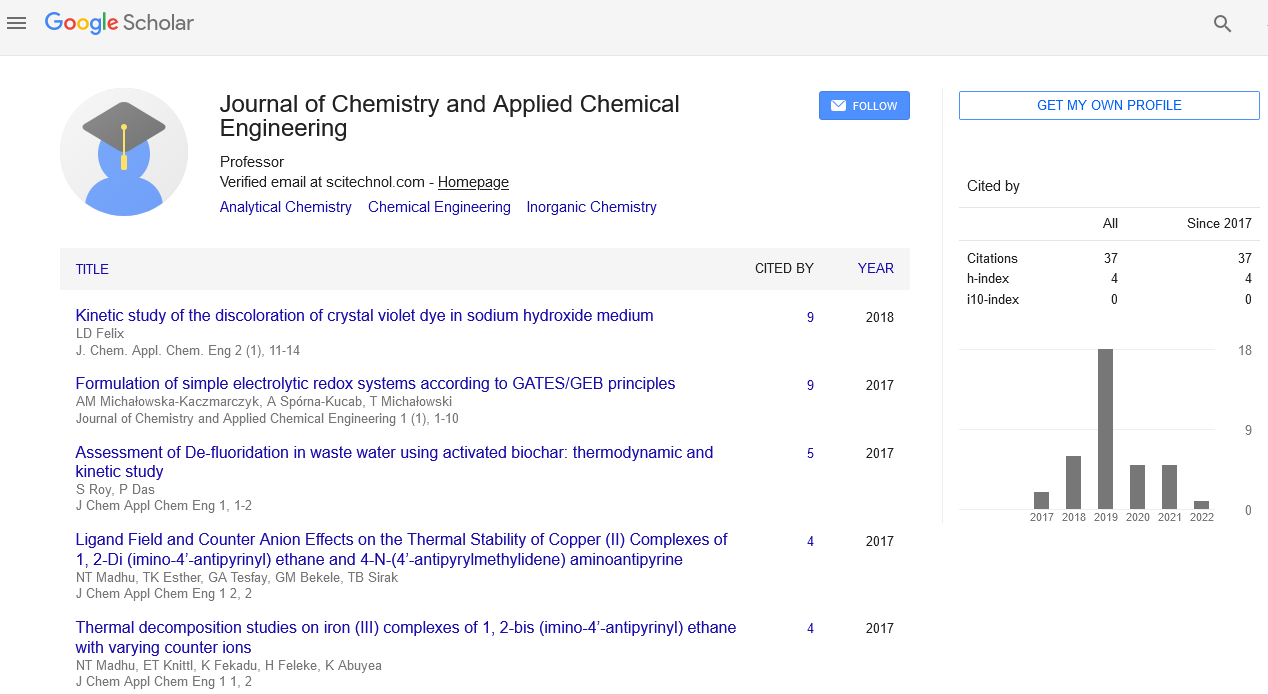Opinion Article, J Chem Appl Chem Eng Vol: 7 Issue: 1
Synthesis and Characterization of Novel Metal-Organic Frameworks for Gas Separation
Qi Li Zhu*
1Department of Carbon Materials, Wenzhou University, Wenzhou, China
*Corresponding Author: Qi Li Zhu
Department of Carbon Materials, Wenzhou
University, Wenzhou, China
E-mail: qili@zhu.edu.cn
Received date: 01 March, 2023, Manuscript No. JCACE-23-93037;
Editor assigned date: 03 March, 2023, Pre QC No. JCACE-23-93037(PQ);
Reviewed date: 17 March, 2023, QC No. JCACE-23-93037;
Revised date: 24 March, 2023, Manuscript No. JCACE-23-93037(R);
Published date: 31 March, 2023, DOI: 10.4172/Jcace.1000e012
Citation: Zhu QL (2023) Synthesis and Characterization of Novel Metal-Organic Frameworks for Gas Separation. J Chem Appl Chem Eng 7:1.
Description
Metal-Organic Frameworks (MOFs) are a type of crystalline porous material that have shown great potential in gas separation applications. These materials are composed of metal ions or clusters connected by organic ligands, forming a three-dimensional network with large surface area and high porosity. MOFs have been used for gas storage and separation due to their ability to selectively adsorb specific gases based on their size, shape, and polarity.
Synthesis of MOFs involves the reaction of metal ions or clusters with organic ligands in a solvent under specific conditions. The choice of metal ions and organic ligands can be varied to achieve specific properties such as porosity, stability, and selectivity. For example, Zrbased MOFs are known for their high stability and tunable pore sizes,
while Cu-based MOFs have high selectivity for CO2 adsorption. The synthesis process typically involves mixing the metal precursor and ligand in a solvent at a specific temperature and time, followed by solvent removal and activation under vacuum or specific gas conditions.
Characterization of MOFs is essential to determine their structural, morphological, and gas adsorption properties. One of the most
common techniques used for MOF characterization is X-Ray Diffraction (XRD), which can provide information about the MOF's crystal structure and purity. Scanning electron microscopy (SEM) and Transmission Electron Microscopy (TEM) can be used to visualize the morphology and size of the MOFs. Gas adsorption measurements, such as Brunauer-Emmett-Teller (BET) analysis, gas permeation, and breakthrough experiments, are used to evaluate the MOF's gas separation performance.
Gas separation performance of MOFs is influenced by several factors such as pore size, surface area, and functional groups. MOFs with larger pore sizes are suited for adsorbing larger gas molecules, while MOFs with smaller pore sizes can selectively adsorb smaller gas molecules. Surface area of MOFs also impacts their gas adsorption capacity and selectivity. Functional groups on MOFs can interact with specific gas molecules, providing additional selectivity.
Several researchers have synthesized and characterized novel MOFs for gas separation. For example, a research group has reported the synthesis of a novel Zr-based MOF with high CO2 adsorption selectivity. They achieved this by incorporating carboxylate groups in the MOF structure, which interacted with CO2 molecules through hydrogen bonding. Another research group reported the synthesis of a novel MOF with tunable pore sizes for selective adsorption of light hydrocarbons. The MOF was synthesized using a combination of two different organic ligands, which resulted in a MOF with a unique structure and pore size distribution.
The synthesis and characterization of novel MOFs for gas separation is an active area of research with the potential to impact various industrial applications. The ability to tailor MOF properties through the choice of metal ions and organic ligands allows for the design of materials with specific gas separation properties. Characterization techniques such as XRD, SEM, TEM, and gas adsorption measurements provide insight into the MOF's structural and gas separation properties. MOFs are promising materials for gas separation due to their high selectivity and potential for use in largescale industrial applications.
 Spanish
Spanish  Chinese
Chinese  Russian
Russian  German
German  French
French  Japanese
Japanese  Portuguese
Portuguese  Hindi
Hindi 